Ballyneety
Published in Early Modern History (1500–1700), Features, Issue 4 (Winter 2000), Volume 8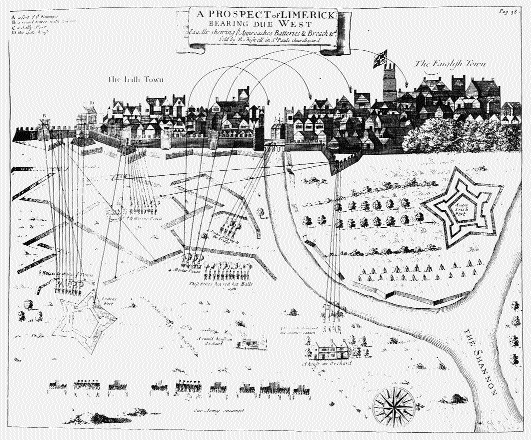
‘A prospect of Limerick bearing due west’ illustrating the siege of Limerick. (Ulster Museum)
The battle of the Boyne was a curious affair. It has generated more potent myths than any other armed encounter in Ireland and has been ridiculously overplayed for partisan purposes. But, in truth, it was no great feat for 36,000 well-trained troops with up to forty field pieces to oust 25,000 who had only six small cannon. The terrain prevented the bulk of both armies from coming to grips with each other and the overall casualties were light. The Jacobites lost 1,000 men (4 per cent) and the Williamites, 5OO (1.4 per cent). The Jacobites withdrew towards Dublin in relatively good shape and next day made plans to rendezvous at Limerick.
The walls of Limerick
As a defensive location Limerick was problematic. It was a twin-city with the older part, the ‘English town’, built on an island bounded by the River Shannon and a small river called the Abbey. On the far side of the Abbey was the ‘Irish town’, linked to the northern half by a stone bridge and more vulnerable as it did not have a water frontage. Both towns were walled, but in many places the mortar had fallen away. The fortifications were medieval rather than seventeenth century: there were neither battlements on the walls nor ramparts on which to mount cannon. Vauban himself, it was said, would have had difficulty in fortifying Limerick.
But the Jacobites had a man familiar with the master’s methods, and who had actually rubbed shoulders with Vauban at Douai, Lille, Maastrict and elsewhere. This was Alexander Rainier, Marquis de Boisselleau; he had participated in nine major sieges and was familiar with the latest techniques in siege warfare. He now assumed responsibility for strengthening Limerick; under his instructions a ‘covered way’ was built outside the walls, consisting of a ditch protected by earthworks and a palisade which ran from the front of St John’s Gate to the East Watergate. Everything was done, however, in haste and some were unsure of the adequacy of the result. Lauzen, the senior French commander was unimpressed and declared, famously, that the walls of Limerick would collapse if pelted with roasted apples.
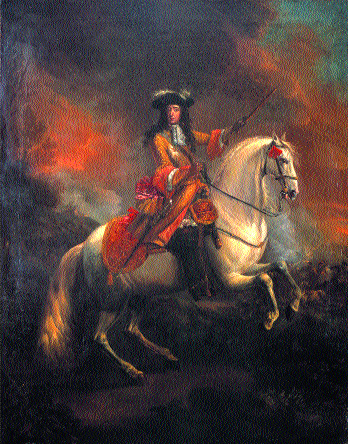
William of Orange by Jan Wyck. (Ulster Museum)
The defence of the city became even more problematic when he announced that he was withdrawing the French regiments to Galway, from where he intended to embark for France; furthermore, he took some of the cannon and ammunition with him.
Sarsfield asserts himself
Tyrconnell, the Jacobite viceroy, was also sceptical that Limerick could be held. He called a meeting of the Irish staff officers and waved a piece of paper in their faces. It was, he said, a declaration signed by some of the most senior personnel stating that Limerick could not withstand a siege for longer than three or four days. We do not know who exactly signed this document, save Lauzen, some of the French officers, and one or two of the Irish commanders. It provoked an uproar. Most of those present spoke angrily against the document and insisted that Limerick could and should be defended, and would countenance no parlay with the Prince of Orange. The leader of this die-hard faction was Patrick Sarsfield, who asserted himself for the first time as a man with a following. From this time until the end of the war he exercised great influence on Jacobite counsels.
It is difficult to establish what type of man Sarsfield was. He never held an independent command and his military achievements are not unqualified. Yet most people, including the English, held him in awe. According to the Duke of Berwick (King James’ illegitimate son by Arabella Churchill), who married his widow, ‘he was a man of amazing stature, utterly void of sense, very good natured and very brave’. He was born at Lucan, County Dublin, around 1650, and was descended, on his father’s side, from an Old English family. His mother was Annie O’More, a daughter of the famed Rory O’More, one of the leaders of the 1641 rebellion. The O’Mores traced their ancestry back to the Milesians and from their seat in County Laois rose in rebellion nineteen times against the Tudors. As a young man Sarsfield was a bit of a tearaway. He was involved in a series of duels and took part in the violent abduction of two wealthy young widows. His military career was initially unpromising and on one occasion he was actually turfed out of the army. He was a convinced Jacobite and served as a volunteer against Monmouth at Sedgemoor, where he was seriously wounded. In the dispute with Tyrconnel he appears to have asserted the forceful side of his character. The viceroy was no shrinking violet himself, yet he yielded to Sarsfield and his associates.
Jacobite resources modest
It was at this time that Bosselleau was appointed governor of Limerick and took command of the garrison. His resources can only be described as modest. He had one regiment of cavalry (which was acknowledged to be of a high standard), one regiment of dragoons, and twenty-eight battalions of infantry. In total, the garrison amounted to about 14,000 men, but many were badly armed. MacMahon’s regiment, for instance, had no weapons at all. In contrast, William (at this time approaching from the direction of Carrick-on Suir) had 25,000 seasoned and well-disciplined troops. His numbers were, however, not as great as expected. Some men had returned to England in the emergency which followed Beachy Head; others had been left to garrison Dublin and the minor posts which had been taken as the Williamites marched south.
Shrewd observers must have seen the defiance of the die-hards as starry-eyed. No betting man would have wagered on Limerick holding out against the power of William. Plainly, Limerick’s salvation (in the absence of French help) could only be found in a diversion or a stunt of some sort. A number of stratagems were thus hatched. Berwick suggested that he should be allowed to use the cavalry to raid the enemy’s lines of communication with a view to cutting them off from Dublin. Tyrconnell thought the idea too venturesome and it was dropped.
On 7 August 1690 William’s army reached Caherconlish about eight miles south-east of Limerick and set up camp. Next morning, at cockcrow, he reconnoitred the city and held a meeting of his high command. Just after noon he sent a trumpeter forward to summon the garrison to surrender. He got no reply, and repeated the exercise a few hours later. This time, all he received was a curt refusal.
William without heavy cannon
The next day began dull and cloudy. A thick mist lay on the Clare hills and fog rose from the River Shannon. As the day progressed the sun broke through and the heat became intense. William instructed that the city be invested and the siege began. But, in truth, he was in a predicament: all he had were light field guns and these were inadequate for the task in hand. He knew, however, that eight heavy cannon would be with him in a matter of days, as his munitions train (or siege train, as it was called) was following slowly behind the main army, and had reached Cashel. Within the week he would be able to level the walls of Limerick.
William did not, however, anticipate the next event. A Huguenot deserter stole into Limerick and spilt the beans about the siege train and even pinpointed its location. This was the act of Providence which the die-hards had prayed for, and Sarsfield saw his opportunity. He renewed Berwick’s request in a more modest form, urging that he should take a troop of cavalry and ambush the siege train before it reached William. This time Tyrconnell did not demur and the audacious Sarsfield sprung into action.
Sarsfield’s ride
At midnight on 9 August, Sarsfield and a company of horse slipped out of Limerick by the north gate. They made for the main cavalry camp at Clare Castle on the Galway road and increased their numbers; these were augmented further by horse relieved from guarding the Shannon ford at Annaghbeg. Then, 500-strong, they followed the west bank of the Shannon, past Bridgetown, Ballycorney, and on to Killaloe where he turned left and followed the river upstream to Ballyvalley; here, he crossed at a ford into County Tipperary. Ahead of him went a quota of scouts to keep an eye out for enemy cavalry and to monitor the progress of the siege train. Sarsfield himself was guided by a man of noted reputation, the raparee Michael ‘Galloping’ Hogan, from the parish of Doon, at the foot of the Slieve Phelims in East Limerick.
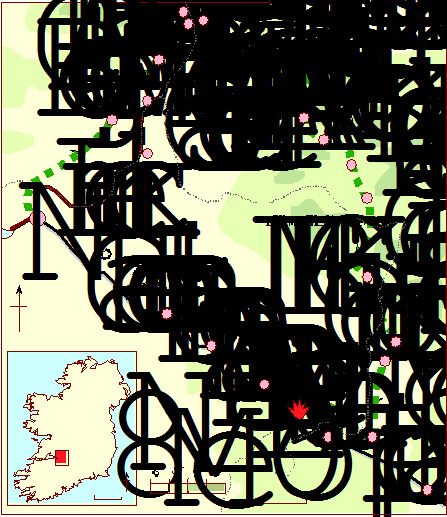
Under the guidance of this expert pilot Sarsfield’s party climbed over the edge of the Silvermine Mountains, went down the west side of Keeper Hill and on through Ballyhuorigan Wood. All movement had to be made by night; there were a number of Protestant estates throughout the area, and their owners were not unlikely to be Williamite sympathisers. Indeed, unbeknown to him, hostile eyes had already spotted Sarsfield. As his 500 horsemen galloped down a laneway near the old twelfth-century cathedral of St Flannan at Killaloe, they were espied by a local Protestant landowner named Manus O’Brien and his colleague Mr Bevin. The onlookers quickly put two and two together.
On Monday morning 11 August, O’Brien and Bevin turned up at William’s camp and told their story. Initially they were unheeded, but O’Brien was insistent and eventually was interviewed by Willem Bentinck, the Duke of Portland, William’s life-long friend. Portland immediately sent a troop to Killaloe to have the story checked out. They returned and confirmed that a number of people had sighted the Jacobites. A report was sent to William, who was busy conducting the siege. He immediately recognised the danger and instructed that two companies of troops be sent out: one to strengthen the escort on the siege train, and the other to locate the whereabouts of Sarsfield. Portland passed these instructions on to Sir John Lanier, but Lanier was lackadaisical in dealing with them; both troops did not saddle up for several hours.
In the meantime Sarsfield was lying low in the vicinity of Glencar, having made his way through Toor, Knockfine and Rearcross. From Glengar he could see right across the Mulkear Valley almost as far as the Galtee Mountains. His scouts had no difficulty in tracking down the siege train. It was snaking its way along the low country, stretching for two miles, enveloped in a permanent cloud of dust. As the day wore on it meandered through the village of Cullen, its wagon master, Willem Meesters, and his commander, Captain Thomas Poultney, unaware that their every move was being watched; at its front and rear it had a small cavalry escort under Colonel Edward Villiers.
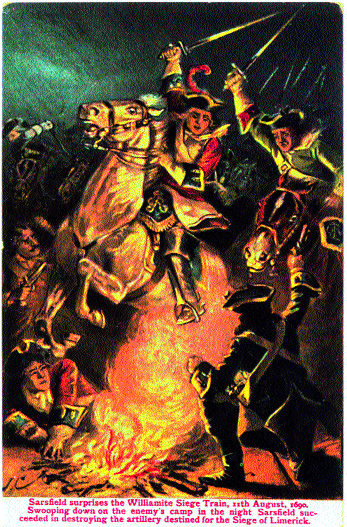
‘Sarsfield surprises the Williamite siege train, 11th August, 1690′.
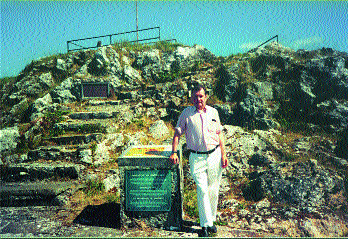
The author beside the plaque unveiled at Ballyneety by President
At dusk the siege train turned off the road and wound its way into a meadow, halting near a large conical rock a few hundred yards from Ballyneety Castle. In County Limerick there are two places called Ballyneety, this one is in the parish of Templebraden, twelve miles south-east of the city. The wagoners lit their fires, took supper, and bedded down. Villiers’ cavalry was camped nearby, their horse champing the grass around them. Sentries were posted, a password arranged, and in a short while all was quiet. It was now that Sarsfield decided to strike. His men, in darkness, stole down from the hills, passed the graveyard at Toem, and then went down by Clonbrick and on to Monard. In this locality Hogan met an old woman he knew; she had been selling apples in the Williamite camp and had learnt the password. It was Sarsfield’s own surname.
‘Sarsfield’s the word, Sarsfield’s the man!’
Around midnight Sarsfield approached the camp. No attack was expected and it was lightly guarded. As the horsemen stole up a sentry was alerted by the undeadened hoofs and challenged: ‘Who goes there?’ At this, Sarsfield sprang out, his horse rearing and answered: ‘Sarsfield is the word, and Patrick Sarsfield is the man.’ In a flash the intruders overwhelmed the stupefied guards. Standing on their stirrups, they galloped through the camp, cutting down, right and left the half-awakened troopers. There was bedlam as the Jacobites wheeled their horses again and again. Dozens of Orange soldiers were killed and the rest ran like hares in all directions. In the heat of the fray a number of non-combatants, some of whom were women, fell victims to the onslaught. This was a serious blemish on an otherwise daringly executed operation.
Sarsfield must have been pleased with his booty. The siege train contained six twenty-four-pounder cannon; two eighteen-pounders; eight brass ordinances of eighteen inches; 800 balls; 120 barrels of powder; 1,600 barrels of match; 500 hand grenades and numerous other munitions. In all there was 153 wagons (drawn by 400 draft horses). Sarsfield instructed that everything be burnt. The cannons were stuffed with powder and their long barrels stuck into the ground. All the carts, shells, powder, and other explosive material was heaped in a circle and a powder trail laid to the end of the meadow. One eyewitness account says that Galloping Hogan was given the honour of lighting the fuse. The powder track spluttered and the flame raced towards the huge mound of powder in the middle of the circle. Then the whole caboodle went sky high. The earth-shaking roar was reputed to be the loudest man-made sound ever heard in Ireland. The night sky went red and the glow could be seen in Limerick. Then there was quiet for several seconds. Next, came a different—crumbling—sound. The walls of nearby Ballyneety Castle—which two centuries earlier had been burnt by the great Earl of Kildare—were shaken by the explosion, and came crashing down.
Following the operation, Sarsfield and his men returned to base by a different route, and so avoided the Williamite force which had sought to intercept them. Lanier was five miles from Ballyneety when he heard the explosion. Realising that he was too late, he diverted to Killaloe in the hope of heading off Sarsfield. He hoped in vain.
When Colonel Albert Cunningham and a troop of Williamites reached Ballyneety at dawn, the burnt grass was still smouldering and pieces of wagon and other debris were scattered all around. The dead bodies, when counted, came to sixty. The number of woman and children among the deceased has always been disputed. Jacobite sources have insisted that they were few, and the Williamites have asserted the opposite. The truth will never be known. The destruction of the siege train was a severe blow to William, but six cannon were salvaged, and others were brought up from Waterford. With these, William began a fresh assault on Limerick in mid-August. For days the guns kept up a constant bombardment and a breech was made in the walls near St John’s gate. The Williamites stormed in and a murderous struggle went on for several hours. Men and women joined the Jacobite soldiers in the defence of the city. Finally, after suffering severe casualties, William withdrew his men. The weather broke and heavy rains caused much damage to his army, and a plague broke out. When his ammunition began to run short William decided to raise the siege. Shortly afterwards he returned to England.
Death of Sarsfield
The war continued until the Treaty of Limerick was signed in October 1691. But Galloping Hogan refused to accept the Treaty and carried on the struggle for a further six months. He left Ireland with the last contingent of the ‘Wild Geese’ to sail from Cork in late spring, 1692.
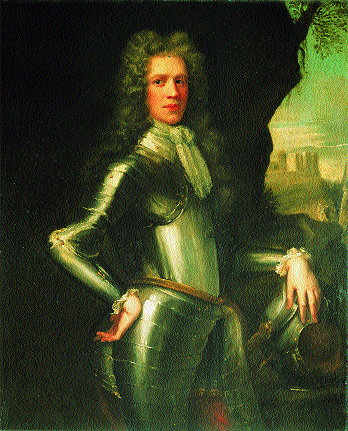
A portrait of a gentleman, possibly Patrick Sarsfield, attributed to John Riley. (National Gallery of Ireland)
Years later he ended his career as a senior officer in the Portuguese army. Sarsfield was fatally wounded while fighting for the French at the Battle of Landen in August 1693. He died a few days later at Huy, in the Austrian Netherlands. In Limerick, but elsewhere too, streets, municipal buildings and sporting teams are named after him. And a fine life-size statue of him stands in the grounds of St John’s Cathedral. Here he is in heroic pose, his left hand pointing towards the scene of his most famous victory: Ballyneety. To-day at Ballyneety one can still see the moonscape holes cut in the ground by the exploding cannon. In 1975 President Cearbhall Ó Dálaigh unveiled an attractive new monument on the site, and the Irish tricolour frequently flies from a flagpole on the conical rock.
Kevin Haddick Flynn is a London-based writer and lecturer.
Further reading:
J.G. Simms, Jacobite Ireland 1686-91 (London 1969).
J. Todhunter, A Life of Patrick Sarsfield (London 1895).
M.J. Culligan-Hogan, The Quest for Galloping Hogan (New York 1982).
















